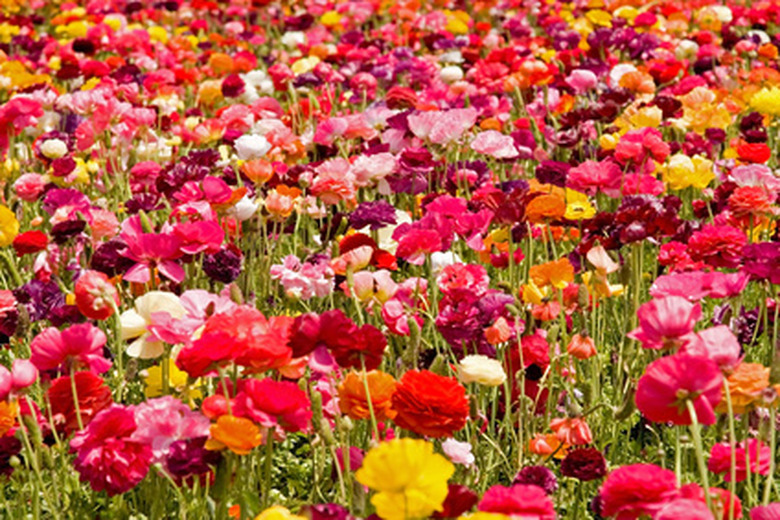How To Grow Ranunculus In Florida
Things Needed
- Ranunculus bulbs
- Shovel, garden fork or rototiller
- Soil amendment
- Trowel
- Fertilizer
Ranunculus (Ranunculus asiaticus) are spring-blooming bulbs that are indigenous to regions in the eastern Mediterranean. They produce showy, 3- to 3 1/2-inch wide, cup-shaped blossoms that are so delicate they closely resemble tissue-paper flowers. Ranunculus come in a wide variety of colors, including red, yellow, white, pink and orange. They can be grown throughout Florida as long as they are provided full sun and good drainage.
Step 1
Turn over the soil in the planting area to a depth of between 8 and 10 inches. Preparing the planting bed is very important when growing bulbs in Florida, according to the University of Florida. Plan on preparing the planting bed about two weeks before you are going to plant the ranunculus.
- Ranunculus (Ranunculus asiaticus) are spring-blooming bulbs that are indigenous to regions in the eastern Mediterranean.
- Plan on preparing the planting bed about two weeks before you are going to plant the ranunculus.
Step 2
Place out over the planting bed a 3- or 4-inch layer of decomposed manure, aged compost, peat moss or any like matter. Work the organic media into the soil thoroughly using a fork, shovel or rototiller, if you have one. Adding a soil amendment is beneficial to help improve the sandy and often acidic soil in Florida.
Step 3
Broadcast fertilizer over the planting bed using a 12-4-8 or similar fertilizer at the rate of 1 cup for every 50 square feet of planting bed. Work the fertilizer into the soil using a fork or a shovel. Then use a soil sterilant to eradicate any pesty garden parasites. This is an important step for areas in South Florida that are known to have a problem with nematodes. Contact your local agriculture extension office for advice on what soil sterilant to use. (Please see the Resource section for contact information).
- Place out over the planting bed a 3- or 4-inch layer of decomposed manure, aged compost, peat moss or any like matter.
- Broadcast fertilizer over the planting bed using a 12-4-8 or similar fertilizer at the rate of 1 cup for every 50 square feet of planting bed.
Step 4
Create rows for planting ranunuclus tubers that are approximately 1 1/2 inches deep and about 12 to 14 inches apart. Place one ranunculus tuber (claw side down) every 6 to 8 inches. Cover the ranunculus tubers with approximately 1 1/2 inches of soil. Or plant the ranuuclus bulbs in drifts for a more informal look. To do this, set the ranunculus tubers out on the surface of the soil and space them about 8 to 10 inches apart from each other. Dig 1 1/2-inch deep holes using a trowel. Set the ranunculus tuber in a planting hole and cover it up with 1 1/2 inches of soil.
- Create rows for planting ranunuclus tubers that are approximately 1 1/2 inches deep and about 12 to 14 inches apart.
- Set the ranunculus tuber in a planting hole and cover it up with 1 1/2 inches of soil.
Step 5
Push in planting stakes around the planting bed so you will know where to water. Then, water the planting bed thoroughly using a fine mist of water until you are certain the planting bed is moistened.
Step 6
Spread a 2- to 3-inch layer of grass clippings, leaf mold or other like organic matter as mulch over the planting bed. Refrain from watering until the ranunculus tubers have sprouted, which can be in a matter of a few weeks, or a few months, depending on what time of year the ranunculus bulbs have been planted.
Step 7
Fertilize the planting bed once the ranunculus bulbs are growing and are about 3 to 4 inches tall. Use a 12-4-8 fertilizer or other type bulb fertilizer. Broadcast fertilizer at the rate of 2 cups (or 1 pound) for every 100 square feet of planting bed and water thoroughly to saturate the soil.
- Push in planting stakes around the planting bed so you will know where to water.
Tip
Plant ranunculus bulbs in Florida between in November through December.
